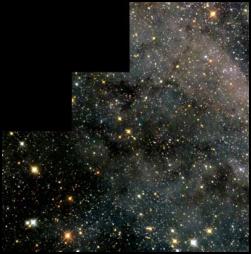Hubble Reveals Star Swarm In Nearby Galaxy
Hubble Reveals Glittering Star Swarm In Nearby Galaxy
STScI NEWS RELEASE
NASA's Hubble Space
Telescope has peered at a small area within the Large
Magellanic Cloud (LMC) to provide the deepest color picture
ever obtained in that satellite galaxy of our own Milky Way.

Image Credit: NASA
and The Hubble Heritage Team (STScI)
Over 10,000 stars can be seen in the photo, covering a region in the LMC about 130 light-years wide. The faintest stars in the picture are some 100 million times dimmer than the human eye's limit of visibility. Our Sun, if located in the LMC, would be one of the faintest stars in the photograph, indistinguishable from the swarm of other similar stars.
Also visible in the image are sheets of glowing gas, and dark patches of interstellar dust silhouetted against the stars and gas behind them.
The LMC is a small companion galaxy of our own Milky Way, visible only from Earth's southern hemisphere. It is named after Ferdinand Magellan, one of the first Europeans to explore the world's southern regions. The LMC attracts the attention of modern-day astronomers because, at a distance of only 168,000 light-years, it is one of the nearest galaxies.
The Wide Field Planetary Camera 2 (WFPC2) image was taken in 1996 in Hubble's "parallel" mode while another of the telescope's instruments, the Faint Object Spectrograph, was taking long exposures of the LMC's Tarantula Nebula. The Tarantula, lying outside the field of view of the WFPC2 photograph, is a tremendous cloud of gas, within which new stars are forming.
NASA astronomers Sally Heap, Eliot Malumuth, and Philip Plait, who work at the Goddard Space Flight Center in Greenbelt, Maryland, pointed Hubble's spectrograph at the core of the Tarantula to investigate its young stars. They also switched on WFPC2 at the same time, in order to obtain the image presented here.
The Hubble Heritage Team later combined the WFPC2 images, taken through different color filters, in order to create the color picture shown here. The range of star colors visible in the WFPC2 image reveals the variety of stellar surface temperatures. Hot stars, with temperatures of 10,000 degrees Celsius and above, have a bluish-white color; stars cooler than our Sun's 6,000 degrees Celsius are reddish.


 Gordon Campbell: On The New Pope, And The Israeli Attack On Peter Davis
Gordon Campbell: On The New Pope, And The Israeli Attack On Peter Davis New Zealand Labour Party: Labour Asks Why Govt Is Silent On Gaza
New Zealand Labour Party: Labour Asks Why Govt Is Silent On Gaza Transport Accident Investigation Commission: Near-Collision Highlights Safety Lessons For All Busy, Unattended Aerodromes
Transport Accident Investigation Commission: Near-Collision Highlights Safety Lessons For All Busy, Unattended Aerodromes Green Party: Wildlife Law Change A Deep Betrayal Of Public Trust
Green Party: Wildlife Law Change A Deep Betrayal Of Public Trust NZCTU: Unions Launch Petition To Protect Pay Equity
NZCTU: Unions Launch Petition To Protect Pay Equity Greenpeace: Greenpeace Slams PM’s Science Pick - 'Polluters Are Running The Show'
Greenpeace: Greenpeace Slams PM’s Science Pick - 'Polluters Are Running The Show' NZ Government: PM’s Science Prizes Celebrate Excellence
NZ Government: PM’s Science Prizes Celebrate Excellence


